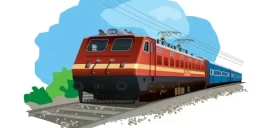Flooding is very dangerous to the permanent way. The earthworks become unstable, ballast can be washed away, and the forces of the water by its movement, buoyancy, and scouring action can seriously weaken and move the track so that it is no longer stable and secure enough to support the weight of a train reliably.
Hence, great care is taken when flood waters rise and affect a railway track. If the trackbed is known to have been laid in a stable manner (or specially built to withstand floods in a flood-prone area), certain rules of thumb are adopted. If the water level does not cover the ballast and the track can be seen to be undamaged, trains may in general move (with caution) over the affected sections. When the water level rises to cover part or all of the ballast, special operating rules go into effect, which differ based on local conditions.
In some divisions, the rules are that if the water does not cover the rails, it may be piloted across with gangmen walking ahead of it and observing the track as it comes under load; while if the water is above the rails, gangmen may have to inspect the entire length of flooded track first and issue a written certificate providing the driver of the train with authority to proceed.
In flood-prone areas like Mumbai, the tracks are built to withstand a certain amount of flooding. In such cases, the rule is generally that trains can proceed (with caution) on flooded track even if the water is a few inches above the rails, as long as the rails can be seen. E.g., on WR, for water less than 3″ above rail level diesel locos are operated at 5km/h, and electric locos at 15km/h. Electric locos can be operated at 8km/h up till 4″ of water, while diesel locos (WDM-2) must not be operated if the water level rises above 3″.
For each class of locomotive, there is a certain height of water beyond which it absolutely cannot proceed on flooded track as its equipment may be damaged otherwise. For instance, diesel locomotives of the WDM-2 class are not to be used if the water level above the rails is more than 3″.
Source – IFRCA.org
Disclaimer: The Information /News /Video provided in this Platform has been collected from different sources. We Believe that “Knowledge Is Power” and our aim is to create general awareness among people and make them powerful through easily accessible Information. NOTE: We do not take any responsibility of authenticity of Information/News/Videos.
This entry was posted in 2 Railway Employee, STUDY NEW, Railway Employee











